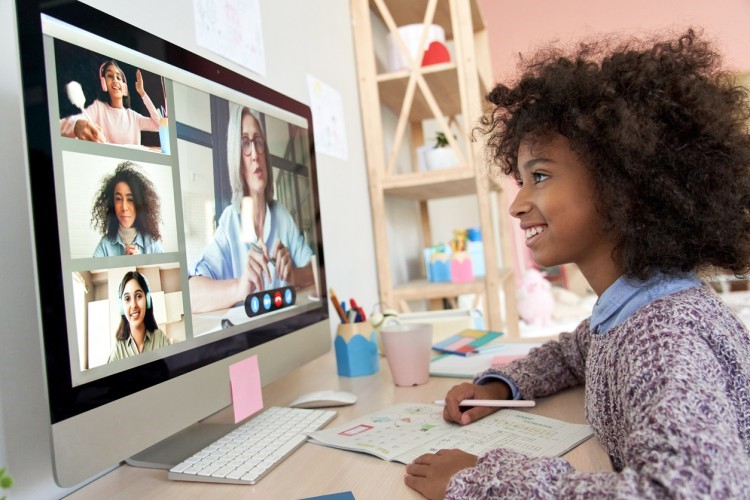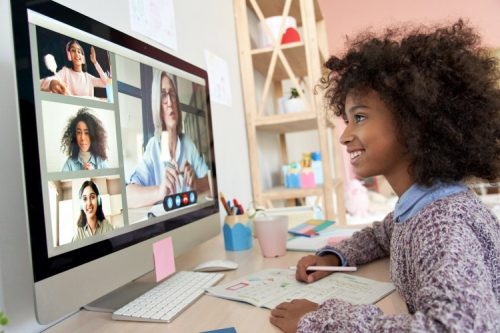Remote Teaching Tips for K-12 Students in 2021

Remote teaching of K-12 students has increased dramatically since the pandemic started in early 2020. According to an August 2020 report from the U.S. Census Bureau, 93% of households with school-age children reported some form of virtual learning during COVID-19.
While remote teaching makes school accessible for many children during this crisis, it also presents unique challenges for teachers, students, and parents who are new to this format. This is why it’s important for current and future teachers, such as those pursuing an online Bachelor of Arts in English degree, to learn strategies for keeping students engaged in remote classrooms.

In a recent Instagram Live discussion, Dr. Steve Coxon, associate professor and executive director of the Center for Access and Achievement (CA²) at Maryville University, shared his best practices for facilitating remote educational experiences and helping young learners reach their full potential.
With a focus on creative learning in STEM, Dr. Coxon is the author of more than 50 publications, including the book Serving Visual-Spatial Learners, which explores students’ ability to think in pictures and complex mental images. In his current role at CA², Coxon helps schools and nonprofits use STEM training to help prepare students for their post-secondary experiences.
“It’s a hugely challenging time,” Dr. Coxon said. “But there’s also, within that, a lot of opportunity for us to really learn about what works for younger people online.”
Tip #1: Provide opportunities for students to engage with each other
In a physical classroom, students can easily work together and have their own conversations. Teachers should find opportunities to recreate this interaction in remote teaching environments.
In his remote fourth-grade class, for example, Dr. Coxon discovered the value in unmuting students’ microphones and empowering them to talk with each other.
“Originally, we thought we had to have all the mics muted, and that was a mistake,” he explained. “[Students] should have time to share about themselves and learn about their teacher; that’s a really important thing for young children. If you spend that time upfront, it’s going to go so much smoother.”
As a result, students who remotely talk with each other can feel more integrated into their educational experiences. As Dr. Coxon said, “The kids feel really comfortable with their teacher and their classmates if they know each other and can build that rapport that will facilitate learning.”
Tip #2: Split classes into smaller groups
Many students can be left behind in a sea of 20-30 video boxes, especially those who thrive with individual attention or who are less likely to speak up. Teachers can encourage students to contribute to class and provide more personalized learning experiences by splitting their classes into small groups.
Last summer, Dr. Coxon cut his three-hour classes down to 90 minutes with 6-8 students in each session.
“On every platform, there’s a way to split kids up into smaller groups,” he said. “Any time that I could spend with one kid or a small group of kids is a million times better than just lecturing to the whole class.”
Tip #3: Empower students to share their work
In remote teaching environments, it’s important to schedule time for students to share and discuss what they’ve been working on, such as individual projects and assignments. In this way, they can feel connected with each other and learn from their classmates — not just the instructor.
That’s why Dr. Coxon made time for his fourth-grade students to share their writing work once a week with different groups of students.
“Everybody likes to do work that’s shared with a real audience, no matter what age,” Dr. Coxon said. “It really encourages students to do their best work and it shows everybody else in the class what other 9-year-olds are capable of. It elevates everything they can share.”
Tip #4: Make content accessible around the clock
Students and parents may need to access schoolwork and educational materials outside of class time. Parents, for instance, may only be able to help with homework at night. Teachers can assist parents in engaging with their children’s education by posting their lessons and videos online.
“Create videos that parents can access through whichever program your school is using,” Dr. Coxon said. “Teachers can record how to do math or provide access to videos, because they’re out there. Teachers can serve as curators to share that, so parents can help their child when it works for them.”
As for parents, Dr. Coxon suggested they embrace these opportunities to bond with their children and have a direct impact on their educational experiences.
“See it as an opportunity to spend more time with your child and more time engaged in their learning,” he said. “Enjoy that time. Tell kids positive stories about your time in school. Kids need to hear that positivity.”
Tip #5: Use a second device to improve visibility
Along with their laptops or desktops, teachers can use smartphones and tablets to juggle different video sessions of small groups. They can also use secondary devices such as connected cameras to capture images from the books they’re using to improve visibility for students.
“You can use it as a document camera for sharing children’s literature, for example,” Dr. Coxon said. “So every kid can see that full screen, and you can point out things in the pictures or specific words.”
Make an impact in remote teaching
Even as schools consider reopening after the pandemic diminishes, remote teaching is expected to make a lasting impact on K-12 education.
As Dr. Coxon remarked, “I don’t think things are ever going to be the same. We’ve given everybody a taste of what this can be like, and it’s not always done well or right, but when it is, there are great learning opportunities.”
Individuals who are interested in building careers as teachers should be able to engage students both in the classroom and online. That’s why Maryville University’s online Bachelor of Arts in English provides future educators with high-demand skills in communication and critical thinking.
Graduates can go on to apply that knowledge in traditional and digital settings, such as physical and remote classrooms, and where they truly make an impact in people’s lives.
Discover more about how Maryville University can help you build a rewarding career in the ever-evolving field of teaching.
Recommended Reading
Leading in a Time of Educational Change
Teaching English as a Second Language (ESL): Resources for Educators
The Future of Education in the Digital Age
Sources
Instagram TV, Maryville Online, “Remote Teaching in 2020 with Dr. Steve Coxon”
United States Census Bureau, “Schooling During the COVID-19 Pandemic”

